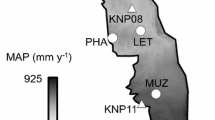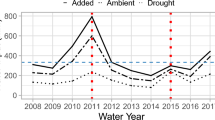Abstract
We conducted a study to test the predictions of Walter's two-layer model in the shortgrass steppe of northeastern Colorado. The model suggests that grasses and woody plants use water resources from different layers of the soil profile. Four plant removal treatments were applied in the spring of 1996 within a plant community codominated by Atriplex canescens (a C4 shrub) and Bouteloua gracilis (a C4 grass). During the subsequent growing season, soil water content was monitored to a depth of 180 cm. In addition, stem and leaf tissue of Atriplex, Bouteloua and the streamside tree Populus sargentii were collected monthly during the growing seasons of 1995 and 1996 for analysis of the δ18O value of plant stem water (for comparison with potential water sources) and the δ13C value of leaves (as an indicator of plant water status). Selective removal of shrubs did not significantly increase water storage at any depth in the measured soil profile. Selective removal of the herbaceous understory (mainly grasses) increased water storage in the top 60 cm of the soil. Some of this water gradually percolated to lower layers, where it was utilized by the shrubs. Based on stem water δ18O values, grasses were exclusively using spring and summer rain extracted from the uppermost soil layers. In contrast, trees were exclusively using groundwater, and the consistent δ13C values of tree leaves over the course of the summer indicated no seasonal changes in gas exchange and therefore minimal water stress in this life-form. Based on anecdotal rooting-depth information and initial measurements of stem water δ18O, shrubs may have also had access to groundwater. However, their overall δ18O values indicated that they mainly used water from spring and summer precipitation events, extracted from subsurface soil layers. These findings indicate that the diversity of life-forms found in this shortgrass steppe community may be a function of the spatial partitioning of soil water resources, and their differential use by grasses, shrubs, and trees. Consequently, our findings support the two-layer model in a broad sense, but indicate a relatively flexible strategy of water acquisition by shrubs.
Similar content being viewed by others
Author information
Authors and Affiliations
Additional information
Received: 23 December 1997 / Accepted: 16 September 1998
Rights and permissions
About this article
Cite this article
Dodd, M., Lauenroth, W. & Welker, J. Differential water resource use by herbaceous and woody plant life-forms in a shortgrass steppe community. Oecologia 117, 504–512 (1998). https://doi.org/10.1007/s004420050686
Issue Date:
DOI: https://doi.org/10.1007/s004420050686




